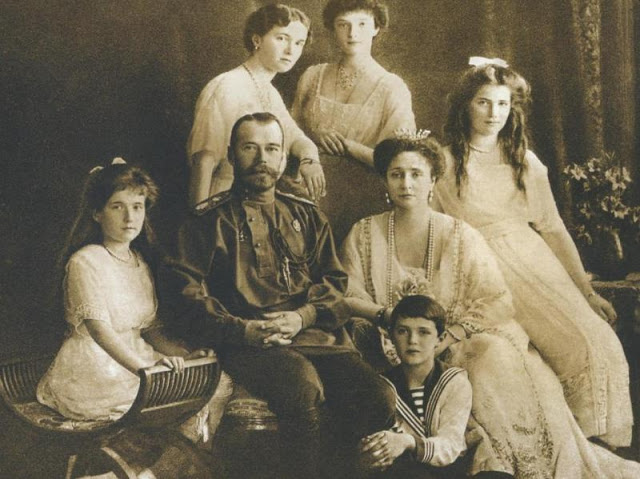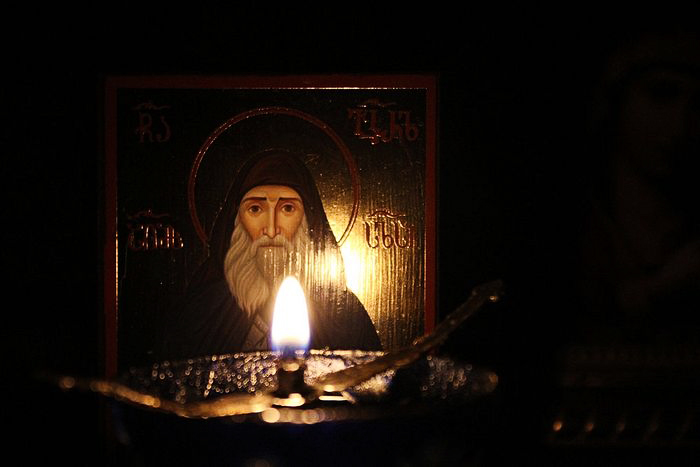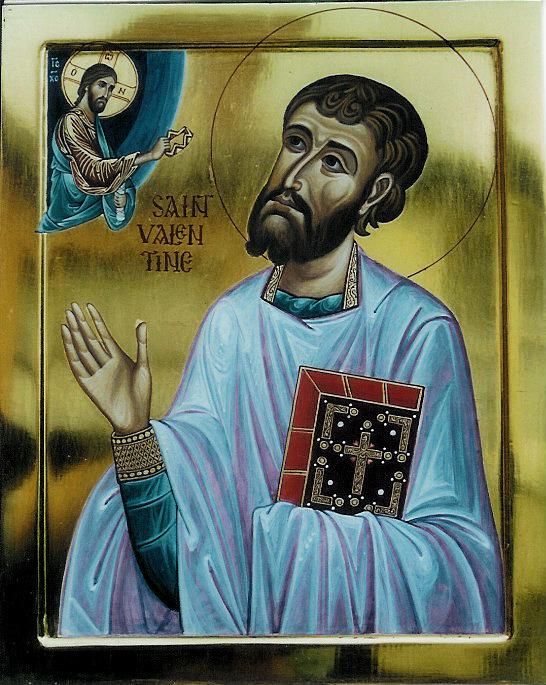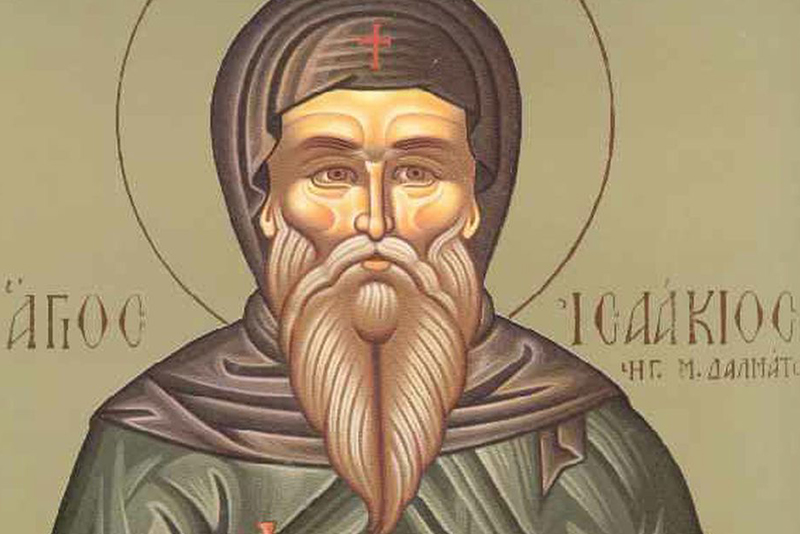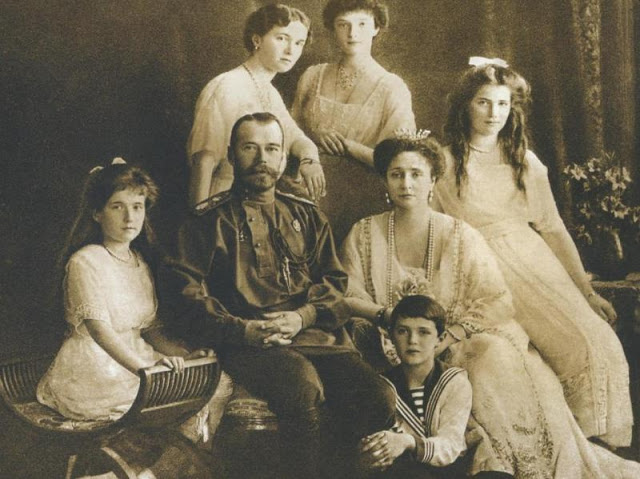
In 1917 Metropolitan Macarius of Moscow saw in a vision the Saviour speaking to Tsar Nicholas: “You see,” said the Lord, “two cups in my hands: one is bitter for your people, and the other is sweet for you.” In the vision the Tsar begged for the bitter cup. The Saviour then took a large glowing coal from the cup and put it in the Tsar’s hands. The Tsar’s whole body then began to grow light, until he was shining like a radiant spirit. Then the vision changed to a field of flowers, in the middle of which Nicholas was distributing manna to a multitude of people. A voice spoke: “The Tsar has taken the guilt of the Russian people upon himself and the Russian people are forgiven.” Nicholas himself once said: “Perhaps an expiatory sacrifice is needed for Russia’s salvation. I will be that sacrifice. May God’s will be done!”
He had a very strong sense of his destiny as an Orthodox ruler. Although he had an opportunity to flee the country with his family and seek refuge outside Russia, he and his Empress deliberately chose to stay and accept whatever awaited them. He had been born on the feast of the Prophet Job and because of this he often remarked to his advisors: “I have a secret conviction that I am destined for a terrible trial, that I shall not receive my reward on this earth.”
Terrible was the night of the murder of the Tsar! On that unspeakable night, the prisoners were all in a deep sleep when they were awakened and ordered to dress in order to leave the city… The Imperial Family descended to the basement where the Sovereign sat down, with his ill son, on a chair in the middle of the room. The Duchesses, the doctor, and three dedicated servants were seated around him. Every one was waiting for the signal to depart. At the executioner’s announcement (which stunned all the prisoners) of the impending execution, the Empress succeeded in crossing herself. She was killed instantly, together with the Sovereign. God spared them from hearing the groans of the Tsarevitch and the cries of the wounded Grand Duchess Anastasia. The first bullets did not bring death to the youngest ones and they were savagely killed with blows of bayonets and gun-butts and with shots at point-blank range.

Olga, the oldest daughter, born in 1895, was fair, with golden-brown hair (the lightest in the family) and beautiful blue eyes. She was innocent, modest, sincere and kind. She liked simplicity and paid little attention to dress. She was most similar to her father, whom she loved better than anyone else. She had a quick mind and possessed the virtue of reasoning. According to her tutors, she had a “crystal” soul and a bright smile; inner joy radiated from her and had an uplifting effect on those around her. Like her father, Olga deeply loved Russia and the Russian people. When faced with the possibility of marriage to a foreign prince, she flatly refused, saying, “I do not want to ever leave Russia. I am Russian and wish to remain so.” Thus she stayed on in her homeland to receive the crown of martyrdom.

Tatiana, the second daughter, born in 1897, was a tall, thin and elegant girl. She had a darker complexion than the others. She was somewhat reserved, dutiful and pensive; she was often more decided in her opinions than her sisters. She was a talented pianist and also painted and embroidered well. Tatiana was her mother’s favorite, having inherited the Empress’ nobleness and sense of discipline. The younger children nicknamed Tatiana “the Governess.”

Maria, the third daughter, born in 1899, was strong, broadly-built and good looking, with light gray eyes. She could paint and draw, and played the piano competently. She was very fond of children and inclined to domesticity, and would have made an excellent wife and mother. Maria had the rare quality of being perfectly happy in ally surroundings, even when the family was imprisoned in Tobolsk. For this reason she was chosen by her parents to accompany them when they were forced to separate from the family and embark upon their last fateful journey to Ekaterinburg.

Anastasia, the youngest daughter, born in 1901, was initially a tomboy and the family clown. She was shorter than the others, had a straight nose and beautiful gray eyes. Refined and witty, she had the talent of a comedienne and made everyone laugh. She had a small dog of Japanese breed, which the whole family loved. Anastasia carried this dog in her arms when she went down into the cellar at Ekaterinburg on the fateful night of July 4th, and the little dog was murdered together with her.

Alexis, the heir apparent, was a very special child. He was born in 1904, in response to prayers offered by the Imperial family and the entire faithful populace during the days of glorification of Saint Seraphim of Sarov, asking God to grant Russia an heir. However, though born the heir lo the Russian Empire, Alexis could not inherit it, since Russia was already set on its apocalyptic course; instead, he inherited an incomparably higher kingdom – the Kingdom of Heaven. Alexis was destined for martyrdom from the moment of his birth: the only and beloved son, he was the young Isaac who was actually sacrificed, the innocent sacrificial lamb who was worthy to atone for the sins of his people. He was born with the dreaded illness of hemophilia, which showed up when he was only six weeks old, and which caused him great pain and suffering for the entire 14 years of his brief life. It was also the cause of the greatest anguish for his family, especially his parents, and was a contributing factor to the fall of the Empire. And yet this young boy bore his terrible burden with great fortitude, silently and without grumbling, in a true Christian manner. At the same time he was like any other boy: he enjoyed games and horseplay, engaged in outdoor activities with other boys whenever possible, loved to go sailing with his father, teased his sisters, liked to watch movies, make boats and other paper models, and, though a very clever boy, was not fond of books. He had a kind heart, liked to give presents everyone, and he loved animals. He was a lively and cheerful child, a universal favorite, beloved by all with whom he came into contact. His mother loved him passionately, suffering a mother’s indescribable anguish over his pains and his illness, which he had inherited from her side of the family.
God granted these extraordinary royal children a spiritually royal fate on earth: after having spent their childhood and youth in a most glorious Orthodox way of life, in absolute innocence and purity, they were ready for the crowning touch – the shining crown of martyrdom. Their Calvary began on March 2, 1917, the day of the Tsar-Martyr’s abdication – first in their palace at Tsarskoye Selo, then at the Governor’s house in Tobolsk, and finally, at the Ipatyev house – the “House of Special Purpose” – in Ekaterinburg, they suffered increasing stages of harassment, humiliation and deprivation. Their prison guards became progressively more insolent, heartless and brutal, subjecting them to insult, mockery and torment. The royal martyrs bore it all with great fortitude, strength of spirit, true Christian humility and total acceptance of the will of God. They sought solace in church services, home prayers and spiritual reading. They were heinously murdered, these pure and innocent children, in the night of July 4, 1918, and from the blood-soaked cellar in Ekaterinburg they passed triumphantly into the royal palace of the King of Heaven.
O holy Royal Martyrs Nicholas, Alexandra, Alexis, Olga, Tabana, Maria and Anastasia, pray to God for us!

